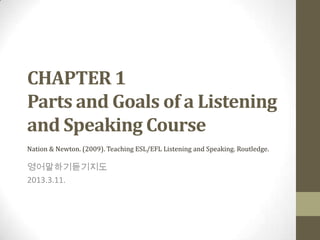
Chapter 1
- 1. CHAPTER 1 Parts and Goals of a Listening and Speaking Course Nation & Newton. (2009). Teaching ESL/EFL Listening and Speaking. Routledge. 영어말하기듣기지도 2013.3.11.
- 2. The Four Strands 1. Learning through meaning-focused input 2. Learning through meaning-focused output 3. Learning through deliberate attention to language items and language features 4. Developing fluent use of known language items and features over the four skills of listening, speaking, reading and writing
- 3. Problems of Extremes • Traditional Grammar Translation Approach • Communicative Language Teaching with no grammar instruction
- 4. The time-on-task principle. 1. A common-sense justification of the four strands is the time-on-task principle. 2. The time-on-task principle simply says that the more time you spend doing something, the better you are likely to be at doing it. 3. Procedural Knowledge vs. Declarative Knowledge (e.g. cycling / swimming)
- 5. Meaning-focused Input • Typical activities • extensive reading • shared reading • listening to stories • watching TV or films • being a listener in a conversation
- 6. Conditions of Meaning-based Input 1. Familiarity 2. Interest and motivation 3. Small portion of language unknown 4. Vocabulary: 95 percent to 98 percent of the running words / Five or preferably only one or two words per hundred should be unknown to learners (Hu and Nation, 2000) 5. Context clues and background knowledge 6. Large quantities of input
- 7. Terms • Krashen’s input hypothesis • Dupay (1999) – narrow listening • Incidental learning • Extensive reading
- 8. Meaning-focused Output • Typical activities • talking in conversations • giving a speech or lecture • writing a letter • writing a note to someone • keeping a diary • telling a story • telling • someone how to do something
- 9. Conditions of Meaning-based Output 1. Familiarity 2. Goal: conveying messages 3. Small portion of language unknown 4. Use of communication strategies, dictionaries, previous input, etc. 5. Plenty of opportunities for output
- 10. Terms • Swain’s (1985) output hypothesis • “Put most simply, the output hypothesis claims that the act of producing language (speaking and writing) constitutes, under certain circumstances, part of the process of second language learning” (Swain, 2005: 471).
- 11. Functions of Output Swain (1995) 1. The noticing/triggering function 2. The hypothesis testing function 3. The metalinguistic (reflective) function
- 12. Language-focused Learning • Different names: focus on form, form-focused instruction, deliberate study and deliberate teaching, learning as opposed to acquisition, intentional learning
- 13. Conditions for language-focused learning 1. deliberate attention to language features 2. process the language features in deep and thoughtful ways 3. spaced, repeated attention to the same features 4. simple and not dependent upon developmental knowledge 5. appear often in the other three strands of the course
- 14. Effects of LF Learning 1. Build implicit knowledge 2. consciousness raising 3. focus on systematic aspects of the language 4. Help develop strategies
- 15. Becoming Fluent in 4 Skills • Relates to all 4 skills of language • E.g. Palmer’s (1925) fundamental guiding principle: Memorise perfectly the largest number of common and useful word groups! (for conversation)
- 16. Conditions of Fluency Development 1. Familiarity 2. Focus on receiving or conveying meaning 3. Some pressure or encouragement to perform faster than usual 4. A large amount of input or output.
- 17. 4/3/2 Technique 1. The same talk is repeated to different listeners in a decreasing time frame (four minutes, then three minutes, then two) 2. Increases both fluency and grammatical accuracy and grammatical complexity
- 18. Principles and the Four Strands 1. Provide and organise large amounts of comprehensible input through both listening and reading. 2. Boost learning through comprehensible input by adding a deliberate element. 3. Support and push learners to produce spoken and written output in a variety of appropriate genres. 4. Provide opportunities for cooperative interaction. 5. Help learners deliberately learn language items and patterns.
- 19. Principles and the Four Strands 6. Train learners in strategies that will contribute to language learning. 7. Provide fluency development activities in each of the four skills 8. Provide a roughly equal balance of the four strands. 9. Plan for the repeated coverage of the most useful language items. 10. Use analysis, monitoring and assessment to help address learners’ language and communication needs.
